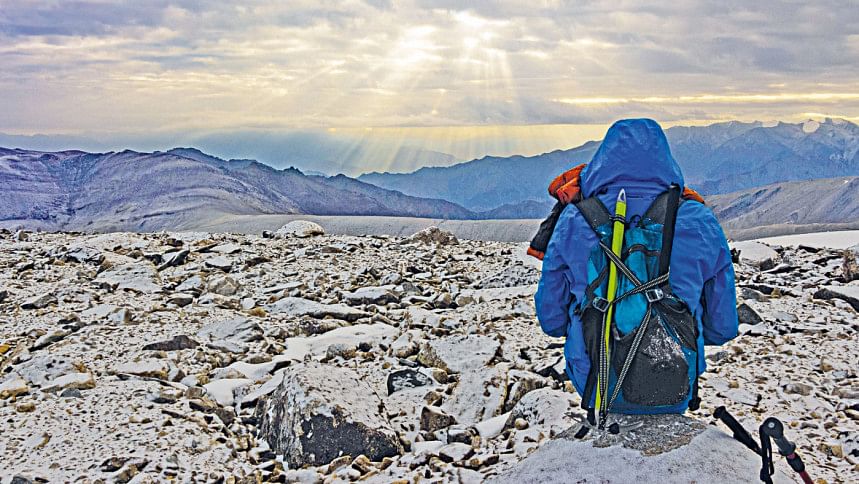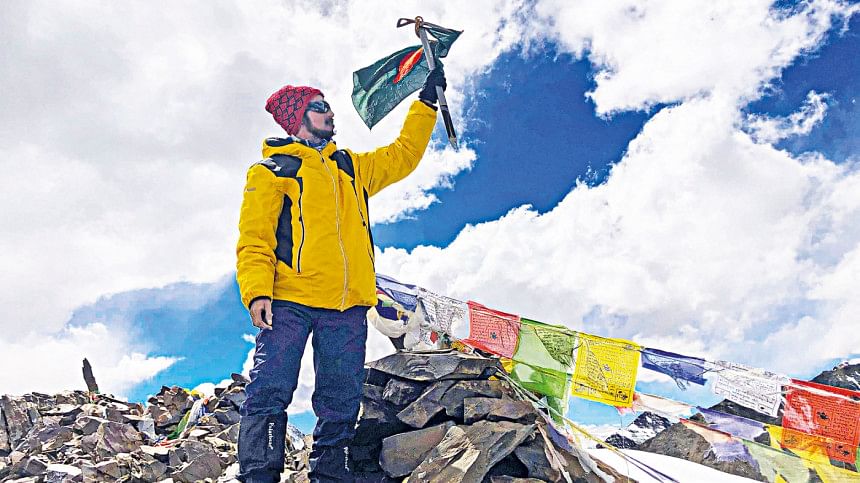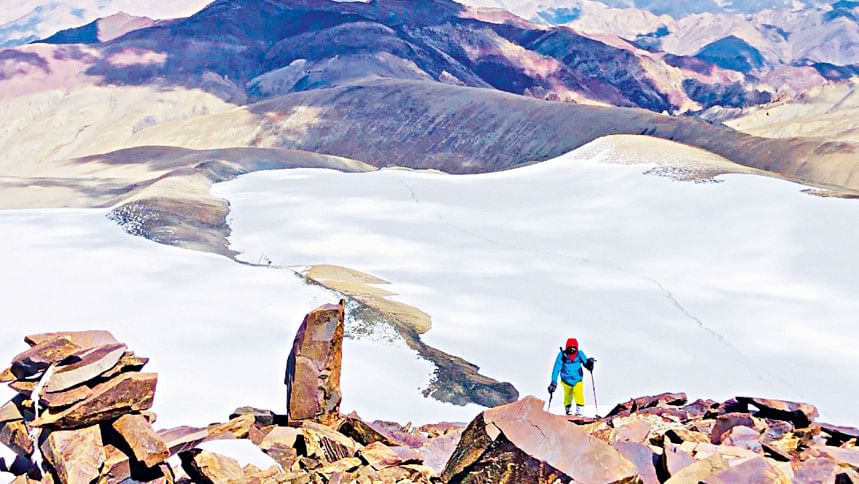Two six thousanders in two days


It was easier than we anticipated.
After scaling Kang Yatse II (6254m), the hardest of the 4 summits we planned to scale as part of the GoZayaan Expedition Ladakh, we were pumped. Many teams attempting Kang Yatse massif in the recent past from Bangladesh have struggled to ascend this giant.
So, when it was done with relative ease, we thought the rest of the expedition would be easier. How wrong we were!
It was 3:00pm, September 13, 2022. After more than 15 hours of hiking, scrambling, and climbing in the high altitude, we were back at the base camp, exhausted. To fulfil the expedition's goal to climb four high-altitude peaks -- Kang Yatse II (6254m), Dzo Zongo East (6214m), Regioni Mallai Ri- I (6120m) and Conga Ri (5755m) -- in just ten days, we had no time to lose.
We were in the Markha Valley of the Western Himalayas located in Hemis national park of Ladakh, a mostly high-altitude frozen desert nestled between the Himalayas and Karakoram. We chose this part of the Himalayas for our expedition, not only for its high-altitude giants but also for its spectacular landscape. The deep-rooted Tibetan culture of the region was a bonus.
Our next goal was to scale the 6120m-high Regioni Mallai Ri.

Ozil and I initially planned to shift the base camp immediately to save a day. The new base camp would be only a couple of kilometres from our present one. It would be a couple of hundred metres higher too, at 5300 metres.
However, packing the tents proved to be a gruelling task. Abandoning the plan, we took refuge in the warmth of our sleeping bags.
The next morning, on the 14th of September, we packed all our belongings and headed towards the Regioni Mallai Ri base camp. Trust me, packing the base camp of a mountaineering expedition is not an easy task. We had to cook our breakfast, clean all the utensils, dismantle the tents, and repack everything accordingly in our backpacks. With only half of the atmospheric oxygen present in the air to breathe, doing all these little tasks wasn't easy.

It took us nearly two hours to repack our things, and another three hours to climb up to the base camp of Regioni Mallai Ri. After setting up the tents, we again went back into our sleeping bags. At midnight, we would set off for our second six thousander. Two six thousanders in two days!
Just two days back, when we started for Kang Yatse II, the full moon flooded the earth, helping the summit push. But this time, thick black clouds covered the moon, enveloping the whole valley in darkness.
We started to climb up the moraine slope just west of our base camp. It was actually a giant hump. We moved quickly, reaching 5500m. Just after reaching the top of the hump after two hours, at around 2 am, it started snowing.
The white weightless snowflakes were coming down from the dark sky and sparkled like a diamond reflecting on the beams of our headlamps. It was a sight to behold.

As the snowfall was getting heavier, visibility became an issue and forced us to assess the situation. According to our map, we were getting closer to a ridge which leads to the summit. So after discussing the pros and cons, we decided to go ahead without wasting time.
It was a large boulder zone. There were some humps of rocks which were almost 20-30 metres in height. We traversed a couple of those and could finally see the ridge which was supposed to lead us to the summit.

But in the darkness, the ridge didn't fully reveal its secret. After advancing for another three hours in snowfall, I was feeling very cold. My toes were getting numb. We could see the ridge but were not sure whether it would lead us to the summit or not. We decided to wait for the sun to rise. In the mountains, taking unnecessary risks can be fatal.
We were again fortunate enough to witness one of the grandest sunrises from the lap of the Himalayas.

The divine sunrise boosted our spirits. Finally, we could clearly see the whole ridge that connects to the summit itself. But what we saw came as shock. Just before the summit, the ridge was broken. That means we could not just follow the ridge up to the summit. We need to revise our route completely.
Ozil and I shared our views and unanimously decided to bypass the broken part. For this, we decided to negotiate the ridge first, then we would climb down to the glacier below where the ridge is broken. After covering the broken part, we would climb up through a connecting ridge to the main ridge.
It was supposed to be an easy climb. We were at 5800 metres, merely 300 metres below the summit. It was merely a thousand metres away!
The descending part from the ridge through the loose rockfall zone proved to be harder than we anticipated. A moment's lack of concentration or a single mishap could have resulted in a few hundred-metre fall on hard rock. We were not mentally prepared for that.
Again we took a break, calmed our senses and started to go down again. When we hit the glacier, we were at 5500 meters. That means we had to climb more than 600 meters.

We moved with extra caution over the glacier. It took us about half an hour to cross the broken section.
And the hardest part waited for us after that. We had to go up through an untested, steep path. Apart from loose rocks, the area was covered with thin ice, making it trickier.

It took us around 5 long hours to climb the rest of the slope. At around noon, we stood on top of 6120m Regioni Mallai Ri.
We were tired and exhausted. But the reward from the peak was outstanding. A great panorama from the summit could be seen, especially the Kang Yatze massif and the hidden parts of the Dzo Jongo peaks and their glaciers. A moment like that is worth all the pains and pangs of an expedition.
We descended to our camp safely.

Scaling Regioni Mallai Ri taught us a hard lesson: no objective in the mountains is easy.
Our overconfidence almost pushed us to potential harm. You can't be restless in the mountains. To traverse the hidden dangers of the high mountains, one needs to be calm. With calmness comes clarity, which is essential for making sound, potentially life-saving decisions. And then there's your grit, endurance, and never quit mindset – the qualities you develop over time.

This successful ascent to Regioni Mallai Ri boosted our confidence once again, and now we were ready to tackle Dzo Zongo Twins, the last two peaks to complete our challenge.
That story is coming up in the next chapter.


 For all latest news, follow The Daily Star's Google News channel.
For all latest news, follow The Daily Star's Google News channel. 



Comments